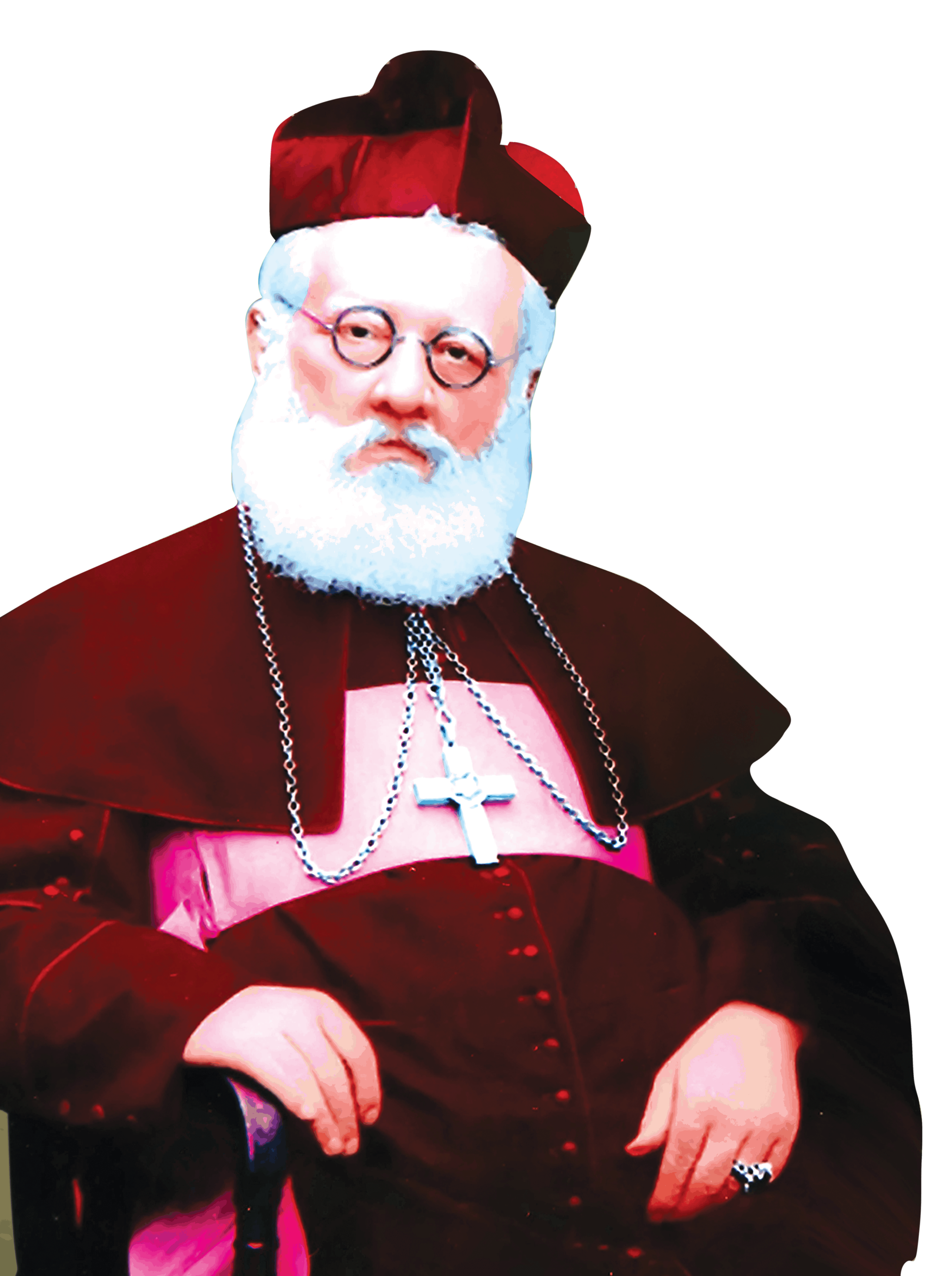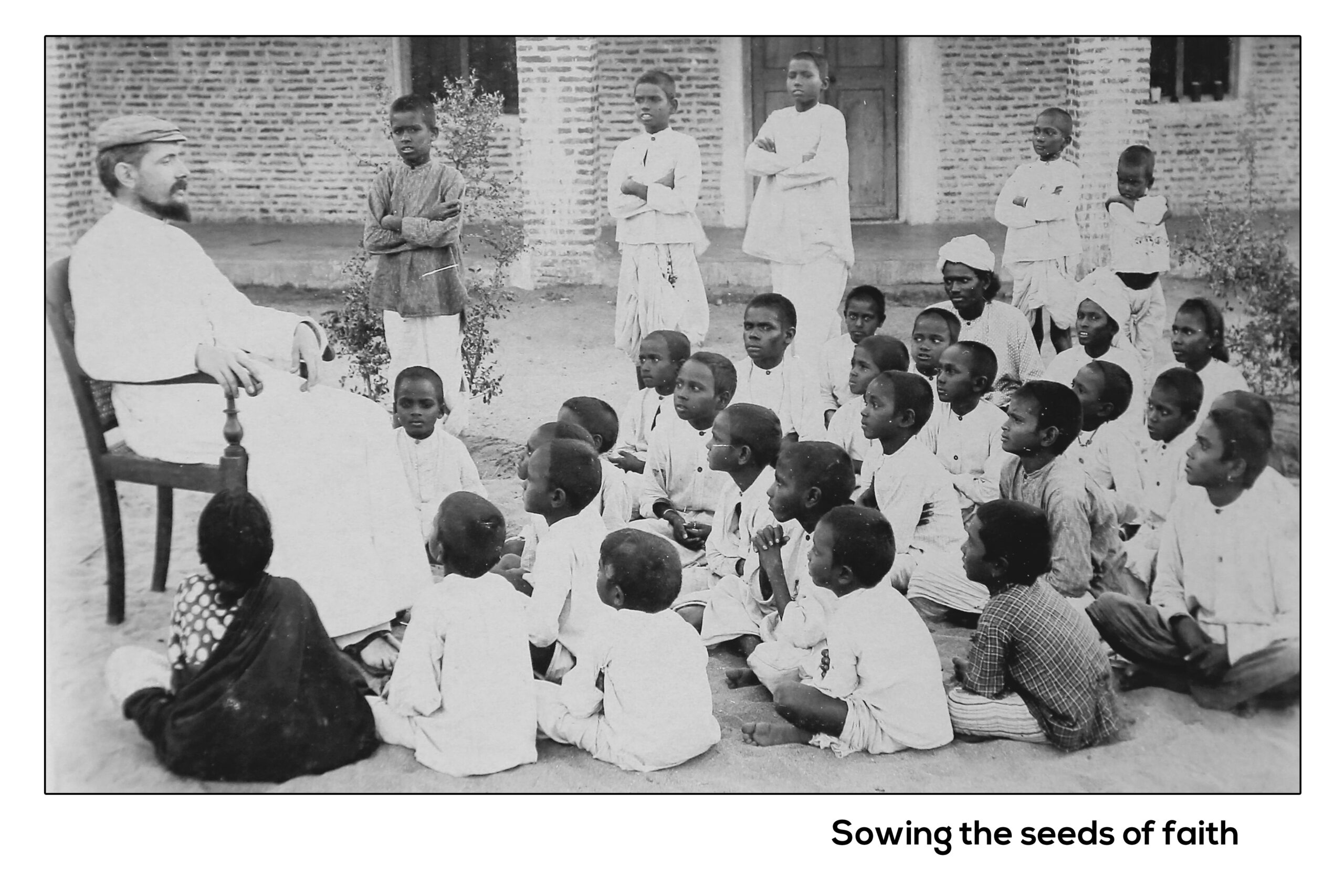Home » About
Throughout the history of mankind, God always hears the cry of those who suffer most. The roots of our congregation originated in the poorest part of Tamil Nadu where discriminations prevailed in the name of caste, religion, customs and beliefs which eventually lead to severe exploitation of the masses. Fr. John Aelen, a Mill Hill Missionary who was appointed as the parish priest at Vepery in 1881, with a prophetic and evangelical zeal, founded an indigenous congregation of the Franciscan sisters of St. Joseph on the 13 Feb 1883 with an insatiable thirst to emancipate the oppressed, the marginalised and alleviate the weaker sections of the hierarchically structured society.
It has been considered for several years that the founder of the congregation of the Franciscan Sisters of St. Joseph was Most Rev. Joseph Colgan, the Archbishop of Madras in 1887. It is only on the occasion of the centenary celebrations of our congregation the absence of the written documents to substantiate this fact was deeply felt. As there was just a brief reference to Fr. Aelen , we held on to the tradition of Bishop Joseph Colgan as founder till the light of revelation about the founder of our congregation came to dispel the darkness of ignorance.
Help came from the unexpected quarters. The New Leader issue of 7th February 1988 brought to our notice by Fr.S.J.Anthonysamy, Scripture Scholar ,Sacred Heart Seminary ,Poonamallee, a well-wisher of the congregation both surprised and delighted us. The reason was the details found in the lengthy article titled,” The Mill Hill Missionaries in India”. The various services rendered by the Mill Hill Missionaries during a period of nearly 60 years in Madras, were listed in it, one of which was a statement about the founding of the Congregation of the Franciscan Sisters of St. Joseph by Fr. John Aelen in 1883. When we contacted the author of this essay he directed us to Fr. Dalziel MHM. He inturn acknowledged that he had obtained the information from Fr. Jim Borst MHM. The search continued. On encountering Fr. Jim Borst many facts were disclosed.
Responding to our many queries ,Fr. Jim Borst sent an extract from the 1975 issue of ‘Mill Hilliana’ . The news letter written by Bishop Simeoni, The prefect of the Congregation for the Propagation of Faith in Rome. The letters written by Fr. John Aelen himself which directly refer to the origin and the purpose of our congregation . These letters have been retrieved from the Mill Hill archives in England by Fr. Jim Borst in 1988. On the 13th of November the same year, Mother General Mary Cyrilla and the Assistant General Mary Venantia recieved the letters from him at Nav Sadana , a pastoral institute in Varanasi. “ I make a gift of this treasure to your congregation “ said Fr. Jim Borst,” handing over the documents to them. The next stage of our search found us in the archives of the archdiocese of Madras – Mylapore where we found the details about the origin of our congregation in the Annual Directories.

One of the most fascinating discovery made from the directories of the Archdiocese of Madras was the facts concerning the name of our congregation. From 1883 to 1894 the congregation was referred to as the branch of the congregation of St Louis de Gonzague.
From 1895 to 1962 the name of the congregation is given as “ The third order Regular of St. Francis of Assisi”. In 1895 this new name was given to the Congregation by the most Rev. Joseph Colgan the First Archbishop of Madras. History provides the link . It was in that very year 1895 that Fr, John Aelen was appointed ‘Visitator Generalis’ of the Mill Hill missions as recorded in the Mill Hill archives and returned to Madras after a brief sojorn in Holland. It was not a mere coincidence that he was in Madras at the time when the name of the congregation was changed.
Yet another change of name took place in 1962 and this time the person instrumental for this change was the first Archbishop of Madras – Mylapore, Most Rev. Dr. Louis Mathias SDB. In order to bestow a specific identity to the congregation he changed the name from a general one to the more specific ‘FRANCISCAN SISTERS OF ST.JOSEPH’ and this has remained.
Bishop John Aelen requested Msgr Francis Jean Maria Laouenan, Bishop of Pondicherry, to send four sisters from the Congregation of Franciscan Sisters of St Aloysius Gonzaga, Pondicherry (FSAG),to help him in guiding and directing the sisters of the new Congregation. Three sisters, under the leadership of Mother Kanickaimary, helped the Congregation in its inception to grow into a mature one. On February 13, 1883, three postulants, namely Rosammal, Rasammal and Antoniammal joined and lived with the sisters sharing their work and life style.
On February 2, 1884, they were admitted as aspirants to receive formation and became the members of the Congregation. Fr. John Aelen never failed to help and support Mother Kanickaimary who was temporarily given the responsibility of leading the Congregation by guiding and directing the aspirants to a life of commitment by word and example. With the help of the sisters two schools were established in order to reach out to the poorest of the poor. By imparting education to these poor people, the sisters helped to break the shackles of ignorance and superstition. On October 8, 1885, the three aspirants were received into the order of the novices. Due to an intensive formation, they grew intellectually and spiritually. On the feast of St Joseph on March 19, 1887 the first three candidates Rosammal,Rasammal and Antoniammal made their first religious profession of a new life. They were given new names Rosammal Became Sr. Mary Francis, Rasammal as Sr. Gertrude and Anthoniammal as Sr. Josephine. The first profession of the three sisters was solemnized by His Grace, Archbishop Joseph Colgan, in a high mass at St. Andrew’s church, Vepery. Fr. John Aelen witnessed it with joy and pride. The newly professed sisters were given long brown habits and black veil. To denote the three vows of poverty , chastity and obedience , which they had now taken, a thick cord with three knots were tied around their waist. It was also a symbol of life of mortification. In order to emphasize the Franciscan spirituality , the ‘TAU’ symbol replaced the usual cross.
(Tau refers to the nineteenth letter of the Greek alphabet. Its numerical value is 300.tau came from the Phoenician letter, ‘taw’ and it further gave rise to the Roman letter ‘T’ and the Cyrillic letter “Te”. It is a very old symbol and has diverse connotations. Tau is usually considered as the symbol of Franciscan Orders due St Francis’ love for it, symbol of the redemption and of the cross. Almost all Franciscan Churches have painted a tau with two crossing arms, both with stigmata, the one of Jesus and the other of Francis; usually members of the Secular Franciscan Order wear a wooden T in a string with three knots around the neck).
This event marked the birth of the congregation of the Franciscan sisters of St. Joseph


Bishop John Aelen, our founder, offered his supportive presence to Mother Mary Francis the first Superior General of the congregation. This support encouraged her and all the sisters to be convinced of the fact that “Hope will not disappoint us”. Mother Mary Josephine who became the second Superior General of the congregation was imbued with the Spirit of St. Francis of Assisi and she trained the young formees to embrace a life of simplicity and poverty in a spirit of Franciscan joy. During this time the congregation observed the Rule of the Third Order of St. Francis of Assisi. Bishop John Aelen passed away on 11 February, 1929. This was an irreplaceable loss as well as an initial setback for the congregation. Added to this great loss, there was yet another setback for the congregation due to a natural disaster. In October 1942, the floods created a great havoc and the convent at Vepery was submerged in water up to ten feet high. It is very agonising to note that all the historical documents of the congregation were totally destroyed by the floods. It was during the same time the sisters also felt the serious impact of the Second World War, which compelled the sisters to find shelter in other places. Consequently, they moved to Vandavasi, presently, in Thiruvannamalai District. However, this struggle has proved to be fruitful as we witness it today. It should be noted that at her inception the congregation admitted local candidates. However, since 1947 candidates from other states were also admitted to the congregation through the initiative of Rev. Mother Mary Dominic. This initiative was further endorsed in the 28th General Chapter 2010 and a New Directive was formulated and promulgated on 13 May, 2010.
In 1965, the seventy-eight-year-old Mother house was shifted from vepery to a more spacious location at the foot of St Thomas Mount at the initiative of most Rev.Dr Louis Mathias, the Archbishop Of Madras- Mylapore. In 1972, Thomas Hospital was inaugurated commemorating the 19th centenary year of coming of St Thomas, the Apostle to India. In 1974, new houses were opened in the dioceses of Madras- Mylapore, Ootacamund, Kottar and Madurai. In 1986, new apostolates began in the dioceses of Palayamkottai, Tutucorin and Trichy. The Congregation extended itself to serve other states like Andhra Pradesh (Eluru, Nalgonda and Cuddappah), Uttar Pradesh (Agra, Meerut, Gorakhpur), Odisha (Cuttack –Bhuvaneswar), Maharashtra (Mumbai) and Rajasthan (Jaipur).
From January 22, 1997 till the end of May 1998 a historical chapter was organised after 110 years of its inception. This Chapter was a step forward in reading the signs of time and reliving the charism of the Congregation to establish the Kingdom of God. On May 16, 1998 Mother Mary Venantia succeeded Mother Cyrilla as the Superior General. Her administrative skills and exemplary qualities paved the way for the developmental progress of the Congregation in all dimensions. She took initiatives in tracing the history from the remnants of the lost documentations and wrote a book on the history of the Congregation, Ootrai Thedum Neerodai (stream that searches spring) in Tamil and same in English, ‘The Quest’. This serves as a reservoir of the historical events of the Congregation from its inception till now. On April 7, 1998, the Congregation acquired the status of a religious Congregation of Ponitifical Right.
On June 15,1999, the General Council of Congregation decided that regional governance should be introduced to administer the Congregation effectively and efficiently. In May 2004, it was decided that Provincial Governance could be introduced.
From May 2004, Mother Rita Catherine Michael headed the Congregation for two terms with tremendous efficiency and zeal. On March 4, 2012, the Quasquicentennial was celebrated to commemorate the 125th year of the establishment of the Congregation with the motto “ a Blazing Hope.” Mother M. Arockiam is the Superior General since 2016. Being a dynamic person, she is steadily taking steps to streamline the vision and mission of the Congregation to meet the changes and challenges of today’s multi culturalism.